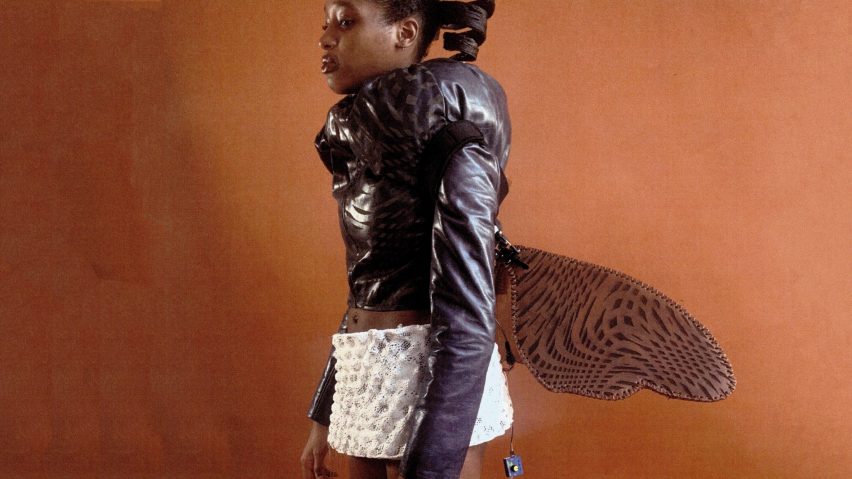Central Saint Martins graduate Yasmina Atta looked to Nollywood film when designing her "shapeshifting" fashion collection, which is an exploration of post-colonial African identity.
The collection, called Kosmos in Blue, comprises three different looks that Atta created during the coronavirus lockdown for her graduate project.
The Nigerian designer brought together an eclectic range of references to create the garments, from African folklore and Hausa architecture to Japanese anime characters and 1960s retrofuturist films.
The resulting designs aim to tell a story of transformation through the creation of this "hybrid" character, which combines elements of mysticism and futurism, and western and African culture.
Her images for the collection have been deliberately given a vintage, low-res feel.
Atta took particular inspiration from Senegalese film director Djibril Diop Mambéty, who was famous for his dream-like depictions of post-independent African society in the 1960s and 70s.
In order to explore "the surreal within a person that emerges from a post-colonial African identity", the designer created an image of a person shapeshifting using motorised butterfly wings.
The wings, which are made from leather that has been laser-etched with traditional tribal patterns, are paired with a leather jacket boasting a puffy collar, a blocky mini skirt and woollen leg warmers.
This so-called hybrid character represents the diverse mix of cultures that arose in many African countries as a result of the European colonisation of the majority of the continent, from which most African countries didn't gain independence until the mid-20th century.
Atta's collection embodies this crossover by channelling elements of mysticism and futurism, taken from both historic and modern African culture as well as contemporary European culture.
More tech-focused methods of mechanical accessories and laser-etched prints are applied to classic materials, like wool and leather, to create a visual depiction of the clash between tradition and pop culture from the 60s.
She also utilised materials such as beads, foam and repurposed cardboard.
"I pulled references from these two cultures [of Europe and Africa] that held aspects of mysticism or visions of the future," Atta told Dezeen.
"I looked at [American jazz musician] Alice Coltrane for instance, but I would also reference Mami Wata, the African deity," she continued.
"The final pieces reflect a blend of this research, but it also becomes open to interpretation."
Some parts of the garments, like the structured leg warmers, reference Japanese anime – the Gundam series in particular, which features giant robots.
For other parts, Atta looked to films from the 1960s featuring American supermodel and actress Donyele Luna to explore representations of the future.
She also wanted to bring in aspects of the Nigerian film industry, otherwise known as "Nollywood", as this showcases western influences alongside ancient beliefs such as African folklore.
A number of Central Saint Martins graduates have recently expanded the boundaries of traditional clothing designs. Fellow Central Saint Martins fashion graduate, Dahee Kim, created garments featuring bulbous back-attachments that double as impromptu beanbag chairs for her final collection.
Based on the design of school uniforms, her collection aimed to channel playful, child-like qualities, including an "abandonment of rules".
Jessan Macatangay, who also graduated from the art and design college this year, used deconstructed chair frames in his designs to symbolise how people carry the weight of personal struggles.
The five looks become progressively lighter and less bulky as they gradually include fewer furniture elements.

